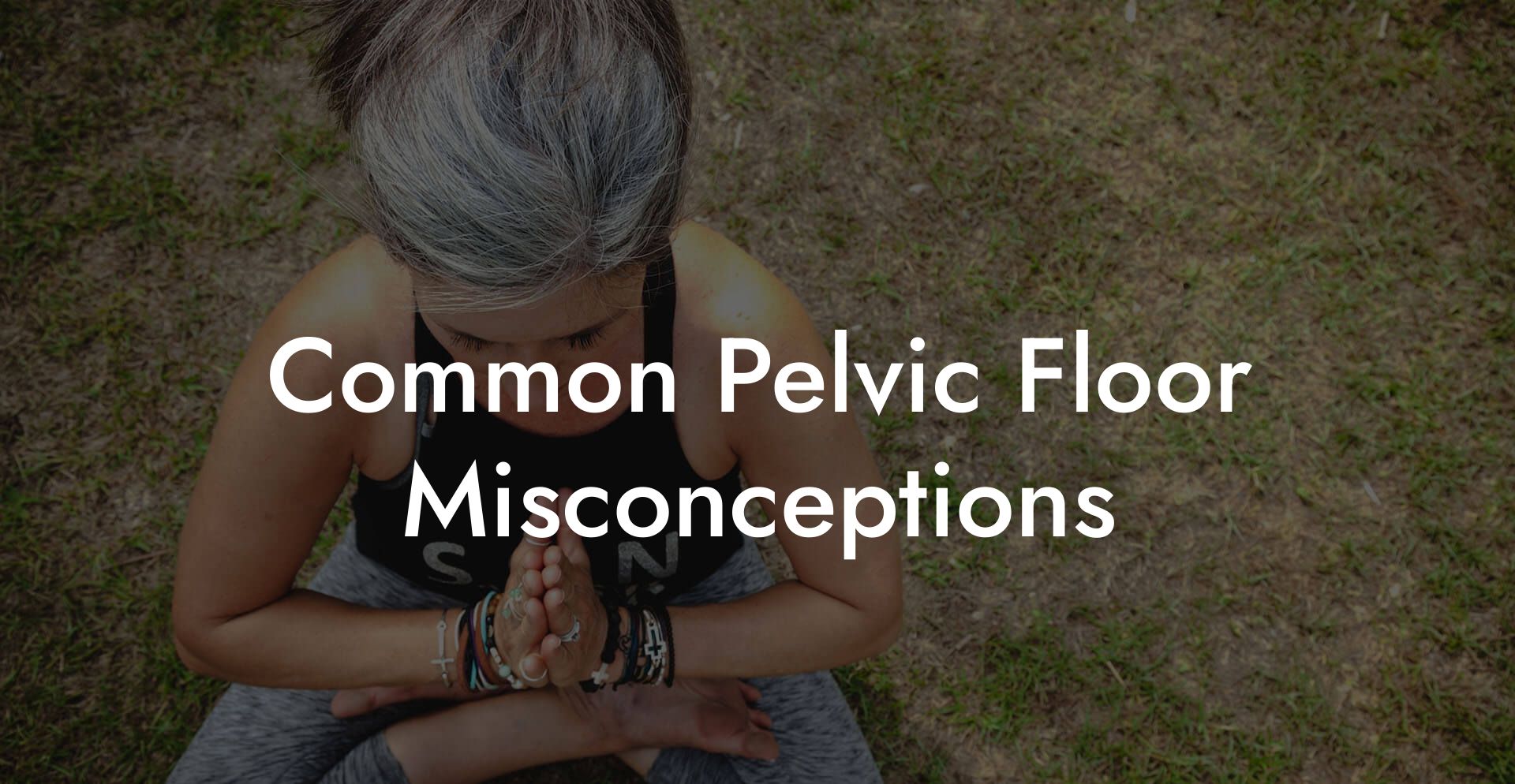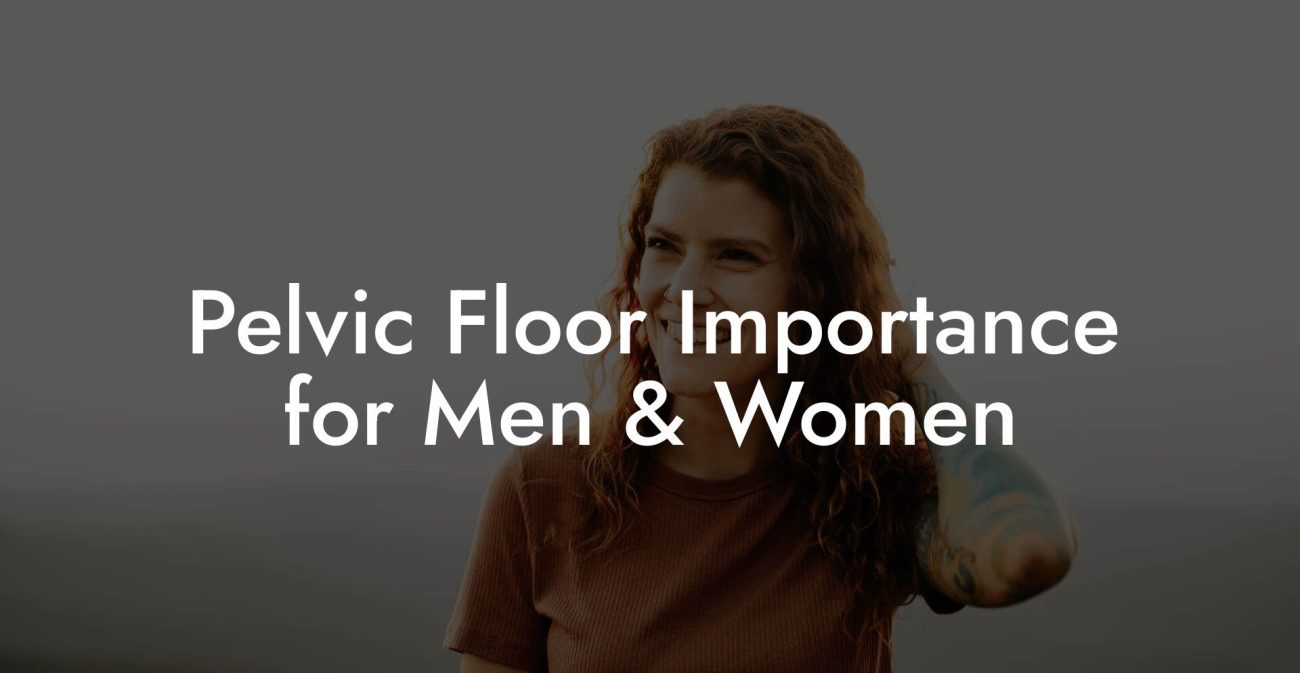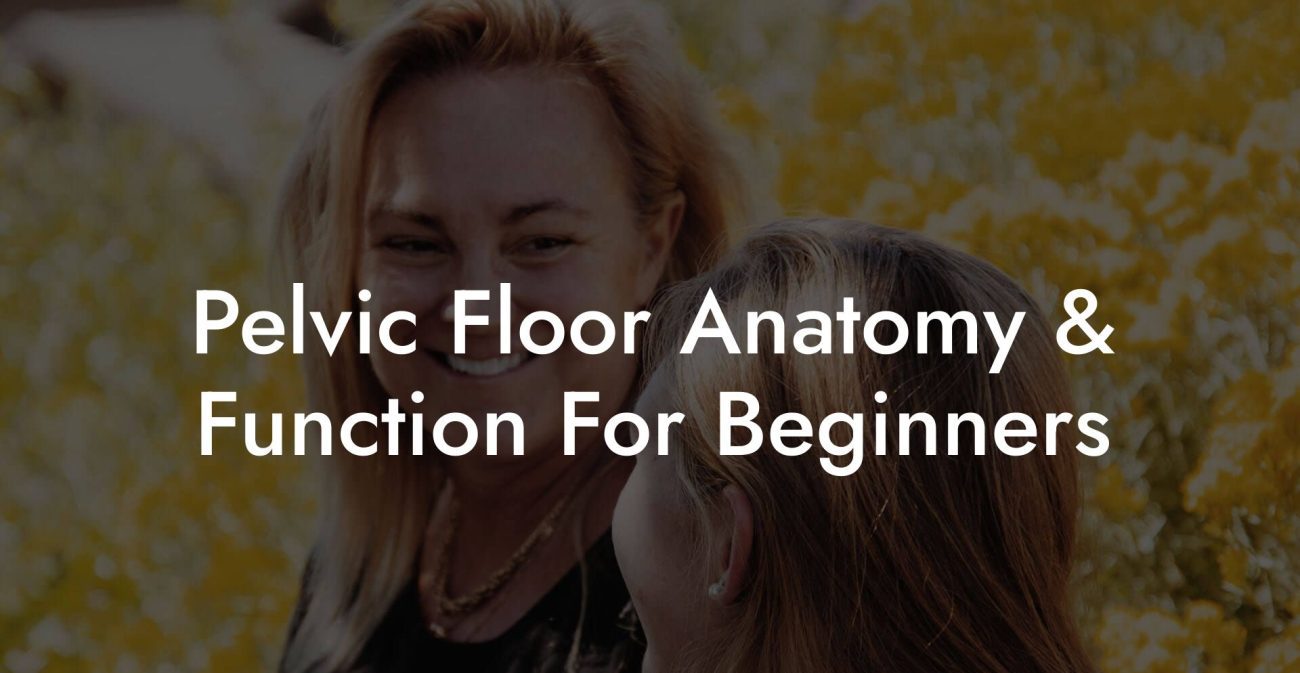Common Pelvic Floor Misconceptions

Forget everything you thought you knew about pelvic floor health, it's time to shatter some myths and set the record straight. Contrary to the common misconceptions circulating online and whispered in gym locker rooms, pelvic floor concerns aren’t exclusive to one gender, age group, or even a one-size-fits-all exercise routine. In fact, if you thought that doing a few Kegels was the magic bullet for pelvic powerhouse perfection, buckle up: there's a lot more to the story. This guide dives deep into the most persistent pelvic floor misconceptions, debunking myths with a blend of science, real-life anecdotes, and a down-to-earth vibe that speaks directly to Gen-Z and millennial readers. Get ready to peel back layers of misinformation and discover tips, strategies, and the empowered truth behind pelvic floor exercises, pelvic floor health, and pelvic floor therapy.
Quick Links to Useful Sections
- Unpacking Pelvic Floor Misconceptions: Separating Fact from Fiction
- Misconception #1: Pelvic Floor Exercises Are Only for Women
- Misconception #2: Kegels Are All You Need for a Strong Pelvic Floor
- Misconception #3: Pelvic Floor Issues Are Only a Problem for Older Adults
- Misconception #4: There’s a Quick Fix or Magic Gadget to Cure Pelvic Floor Dysfunction
- Misconception #5: Pelvic Floor Health Is Unrelated to Overall Core Strength and Fitness
- The Realities Behind the Myths: Why Misconceptions Persist
- Bridging the Knowledge Gap: Empower Yourself with Accurate Information
- Dive into Evidence-Based Resources
- Get Professional Guidance
- Embrace a Holistic Approach
- Stay Open and Curious
- Resources and Community Support: Your Next Steps
- Pelvic Floor Misconceptions FAQs: Your Burning Questions Answered
- Your Path to Empowered Pelvic Floor Health
Unpacking Pelvic Floor Misconceptions: Separating Fact from Fiction
Pelvic floor health is one of those topics that seems to come with a laundry list of myths. Whether you’ve scrolled past dubious posts on social media or overheard conversations in the locker room, you might have encountered some half-truths about what the pelvic floor is and how it works. And yes, while some of these ideas might sound like they’re straight out of an old wives’ tale, they persist even in our modern era of wellness and biohacking.
At its core, the pelvic floor is a group of muscles, ligaments, and connective tissues that form an essential supportive hammock for your bladder, uterus (or prostate), and rectum. It plays a pivotal role in continence, core stabilization, and even sexual health. Yet, despite (or perhaps because of) its importance, many misconceptions about the pelvic floor float around, often clouding judgment and misleading people about the best ways to care for this vital area.
In the sections that follow, we’ll tackle these myths head on. Think of this as your myth-busting crash course that empowers you with not just the “how” but also the “why” behind effective pelvic floor health strategies. Ready to dive in? Let’s debunk some bad habits and outdated ideas together.
Misconception #1: Pelvic Floor Exercises Are Only for Women
One of the most stubborn myths in the world of pelvic floor health is that these exercises are exclusively a woman's domain. From the casual advice columns to the quirky workout videos on TikTok, a teetering consensus suggests that only women need to worry about Kegels and pelvic strengthening. But guess what? This is a major oversimplification, if not an outright misinformation.
Men have pelvic floor muscles too, and these muscles are just as crucial for maintaining bladder control, sexual function, and even core stability. For many men, pelvic floor dysfunction can lead to issues like incontinence, erectile dysfunction, and chronic pelvic pain. Whether you're recovering from prostate surgery, battling urinary challenges, or simply trying to improve your overall core performance, incorporating pelvic floor exercises into your regimen is a slam dunk.
The notion that pelvic floor exercises are gender-specific ignores the anatomical reality: both men and women can experience pelvic floor weaknesses and imbalances. In fact, modern health professionals are increasingly recognizing that a holistic approach to pelvic floor therapy benefits everyone, regardless of gender. So, next time you hear someone claim that pelvic floor workouts are a “women-only” club, feel free to set the record straight, and maybe even share a few science-backed tips from this guide.
Misconception #2: Kegels Are All You Need for a Strong Pelvic Floor
If you’ve ever been told that a few sets of Kegels a day will transform your pelvic floor, you’re not alone. The Kegel exercise, popularized decades ago, has earned its status as a go-to move for pelvic floor strengthening. However, while Kegels have their place, relying solely on them can be like trying to build a gourmet meal with just one ingredient.
Build strength, control, and confidence with this practical ebook. Learn the anatomy, spot symptoms early, and follow a structured four week plan that fits real life. Master safe technique, progress at a steady pace, and support your results with simple nutrition.
You will learn:
- How the pelvic floor works
- Signs of weakness and when to seek help
- Basic to advanced exercises with clear cues
- A four week plan you can follow anywhere
- Yoga and Pilates integrations
- Equipment tips for added challenge
- Food choices that support recovery
- Real success stories for motivation
Perfect for:
- Better intimacy and daily comfort
- Leaks during your day-to-day life
- Postpartum recovery
- Core stability and posture
Start today and take back control of your body.
The pelvic floor is a complex network of muscles that needs a nuanced approach. Just as you wouldn’t expect a robust workout by focusing solely on bicep curls, you shouldn’t expect a fully functional pelvic floor by doing only Kegels. The truth is, effective pelvic floor therapy often involves a combination of exercise types, ranging from reverse Kegels and dynamic functional movements to integrated core and glute workouts. Each of these exercises targets different aspects of pelvic functionality, ensuring that no muscle is left behind.
Moreover, exclusive Kegel routines sometimes risk overworking certain muscles, leading to tension and discomfort rather than balanced strength. Think of it as overusing your smartphone’s camera without ever exploring its other features, the result is a one-dimensional skill set that doesn’t capture the full picture of your potential. For a well-rounded approach, consider integrating dynamic movements, stretching, and even mindful relaxation techniques into your pelvic floor regimen.
In short, while Kegels are a valuable tool, they’re just one piece of the puzzle. A multi-modal workout plan curated by pelvic floor specialists or therapists can provide a more balanced, effective solution.
Misconception #3: Pelvic Floor Issues Are Only a Problem for Older Adults
Another pervasive myth is the idea that pelvic floor dysfunction is something that only affects the “golden agers” of society. The stereotype suggests that if you’re young, fit, and active, your pelvic floor is in the clear. But here’s a reality check: pelvic floor issues can impact individuals at any stage of life.
For younger people, factors such as childbirth, heavy lifting, high-impact sports, and even prolonged sitting (yep, all those Zoom marathons count) can contribute to pelvic floor imbalances. In today’s digitally dominated lifestyle, many millennials and Gen-Zers are unknowingly putting strain on their pelvic muscles. Bad posture, chronic sitting, and stress-inducing routines can lead to early signs of dysfunction.
Additionally, lifestyle choices and environmental factors like nutrition and stress management play significant roles in overall muscle health, including that of the pelvic floor. It’s crucial to understand that pelvic floor wellness is not solely an issue of age; it’s a reflection of our daily habits and bodies’ responses to modern stressors.
So, while it’s true that the natural aging process can affect muscle tone, dismissing younger demographics from the conversation does a disservice to anyone struggling with these issues early on. Whether you’re a young professional or a student juggling a hectic schedule, prioritizing pelvic floor health is essential, not just for preventing future problems, but for enhancing everyday performance and comfort.
Misconception #4: There’s a Quick Fix or Magic Gadget to Cure Pelvic Floor Dysfunction
In the age of instant gratification and viral “life hacks,” it’s no wonder that the idea of a quick-fix solution for pelvic floor dysfunction has taken root. From trendy wearable gadgets to funky online challenges, the allure of a one-size-fits-all shortcut is hard to resist. However, like most things that sound too good to be true, these quick fixes often fall short.
The pelvic floor is not a muscle you can simply “program” with a flashy widget, it demands a comprehensive, personalized approach. Over-reliance on gimmicky devices can lead to inconsistent results and, in some cases, exacerbate your symptoms. Instead of hunting for that elusive magic tool, focus on proven, evidence-based methods, supplemented by professional guidance from pelvic floor therapists.
Effective treatment and management of pelvic floor dysfunction is much more of a marathon than a sprint. It involves a mix of correctly performed exercises, mindful practices, proper nutrition, and sometimes even complementary therapies like massage or acupuncture. Investing time and effort in understanding your body and following a well-rounded plan is far more sustainable (and less frustrating) than expecting an overnight miracle.
Build strength, control, and confidence with this practical ebook. Learn the anatomy, spot symptoms early, and follow a structured four week plan that fits real life. Master safe technique, progress at a steady pace, and support your results with simple nutrition.
You will learn:
- How the pelvic floor works
- Signs of weakness and when to seek help
- Basic to advanced exercises with clear cues
- A four week plan you can follow anywhere
- Yoga and Pilates integrations
- Equipment tips for added challenge
- Food choices that support recovery
- Real success stories for motivation
Perfect for:
- Better intimacy and daily comfort
- Leaks during your day-to-day life
- Postpartum recovery
- Core stability and posture
Start today and take back control of your body.
Remember: building strong, functional muscles is a process that requires consistency, personalization, and patience. So before you get swept up in the next trendy gadget craze, consider dedicating time to an individualized routine that respects the complexity of your pelvic floor.
Misconception #5: Pelvic Floor Health Is Unrelated to Overall Core Strength and Fitness
A common fallacy in the fitness world is that your core and pelvic floor operate independently, each with its own set of exercises and benefits. However, the truth is far more intertwined. The pelvic floor is actually a central component of your core, the unsung hero that supports not only your internal organs but also your posture, balance, and overall stability.
Think of your core as a well-coordinated team, where the abdominal muscles, diaphragm, spinal erectors, and pelvic floor all play interconnected roles. Isolating one component without considering its relationship to the others can lead to imbalances and suboptimal performance. For instance, a weak pelvic floor can compromise your core stability during heavy lifts or high-intensity workouts, increasing the risk of injury.
Fitness professionals and pelvic health experts now advocate for integrated training approaches, ones that combine core stabilization, functional movement, and pelvic floor exercises. This means that whether you’re hitting the gym for a strength training session or rolling out a yoga mat for a home workout, nurturing your pelvic floor is as important as any other muscle group. Incorporating exercises like planks, bridges, and dynamic functional movements can support both core and pelvic floor strength, helping you achieve balanced, overall fitness.
When you view pelvic floor health as an integral aspect of your core, you’re not only reducing the risk of common dysfunctions but also enhancing your performance in everyday activities. Embrace the interconnectedness of your body, and you’ll soon notice improvements in everything from posture to athletic prowess.
The Realities Behind the Myths: Why Misconceptions Persist
So, why do these pelvic floor misconceptions keep cropping up despite advances in medical science and fitness research? A huge part of the problem lies in historical silence and a lack of open conversation about pelvic health. For decades, topics surrounding the pelvic floor were shrouded in embarrassment and taboo, leaving fertile ground for myths and half-truths to take root.
Add to that the modern explosion of social media influencers, viral “remedies,” and oversimplified health advice, and it’s no wonder that misinformation spreads like wildfire. In an era where every other post promises a revolutionary solution to your bodily woes, the nuanced reality gets lost in the noise.
Furthermore, the complexity of the pelvic floor itself, with its multiple layers, functions, and interactions with the rest of your body, makes it an easy target for oversimplification. It’s far simpler to parrot a catchy phrase like “Just do Kegels!” than it is to explain the intricate balance of muscle groups and neural pathways that underpin proper pelvic function.
The persistence of these myths points to a deeper need for education, open dialogue, and accessible, science-backed information. The more we talk openly about pelvic floor health and share real-world experiences along with expert insights, the more we empower individuals to make informed choices about their wellness.
Bridging the Knowledge Gap: Empower Yourself with Accurate Information
Now that we’ve dismantled some of these common misconceptions, it’s time to focus on what really works. Knowledge is power, especially when it comes to something as integral as your pelvic floor. Here are some practical steps to empower yourself with accurate information and effective techniques:
Build strength, control, and confidence with this practical ebook. Learn the anatomy, spot symptoms early, and follow a structured four week plan that fits real life. Master safe technique, progress at a steady pace, and support your results with simple nutrition.
You will learn:
- How the pelvic floor works
- Signs of weakness and when to seek help
- Basic to advanced exercises with clear cues
- A four week plan you can follow anywhere
- Yoga and Pilates integrations
- Equipment tips for added challenge
- Food choices that support recovery
- Real success stories for motivation
Perfect for:
- Better intimacy and daily comfort
- Leaks during your day-to-day life
- Postpartum recovery
- Core stability and posture
Start today and take back control of your body.
Dive into Evidence-Based Resources
First and foremost, seek out information from reputable sources, peer-reviewed journals, certified pelvic health professionals, and trusted health organizations. When it comes to online advice, look for evidence-backed content rather than the latest fad.
Get Professional Guidance
If you’re experiencing pelvic floor issues, there's no substitute for personalized assessments from a pelvic floor therapist or specialist. They can not only correct any misconceptions in your routine but also tailor a program that addresses your unique needs.
Embrace a Holistic Approach
Recognize that pelvic floor wellness extends beyond isolated exercises. Incorporate aspects of overall core strengthening, mindful relaxation, proper nutrition, and lifestyle adjustments to support your body holistically. This multi-modal approach will help create a solid foundation that supports long-term well-being.
Stay Open and Curious
Finally, keep an open mind. Health advice evolves as new research emerges, and what was once considered best practice might be refined over time. Engaging with communities, staying updated on the latest developments, and being willing to adapt your routine are all steps toward sustained pelvic health.
By arming yourself with trustworthy information and adopting a well-rounded strategy, you transform pelvic floor management from a confusing maze of myths into a proactive, informed journey. This empowered approach not only improves your pelvic floor health but also enhances your overall quality of life.
Resources and Community Support: Your Next Steps
Taking control of your pelvic floor health isn’t just about following exercise routines, it’s also about connecting with a community of like-minded individuals and accessing reliable resources. Whether you’re just starting out or you’ve been on this journey for a while, here are some practical tips and resources to keep you on track:
Join Online Communities: Social platforms like Reddit, Facebook groups, and specialized forums offer spaces where people openly discuss pelvic floor experiences, share practical tips, and provide support. These communities are treasure troves of firsthand accounts, success stories, and even cautionary tales that demystify the journey.
Follow Credible Experts: Seek out pelvic health professionals, physiotherapists, and wellness coaches who share evidence-based advice via blogs, podcasts, or YouTube channels. Their expert insights can help you navigate through conflicting advice and stay updated on the latest research.
Explore Educational Content: Websites of reputable health organizations and academic institutions often provide detailed guides, infographics, and instructional videos on pelvic floor exercises, pelvic floor therapy, and overall pelvic health. Bookmark these and refer back whenever you need clarity.
Consider Professional Consultations: While online resources are invaluable, a personal consultation with a pelvic floor specialist can provide tailored advice and hands-on guidance. Many therapists now offer telehealth consultations, making it easier than ever to get expert input from the comfort of your own home.
Adopt a Growth Mindset: Pelvic floor health is a journey that evolves over time. Celebrate your wins, learn from setbacks, and view every step as part of your growth. Consistency, patience, and a willingness to learn are your best tools on this path.
By integrating these resources and community contacts into your routine, you can transform pelvic floor care from an isolated struggle into a collective, empowering experience. Embrace the support around you and remember, knowledge shared is power multiplied.
Pelvic Floor Misconceptions FAQs: Your Burning Questions Answered
We know that confusion about pelvic floor health is rampant, so here are some frequently asked questions that cut through the noise and focus on what truly matters:
1. Are pelvic floor exercises really only for women?
Not at all. Both men and women benefit from pelvic floor exercises, as these muscles are crucial for bladder control, core stability, and sexual health.
2. Is doing Kegels the only way to improve pelvic floor health?
While Kegels are helpful, a comprehensive pelvic floor program should include a variety of exercises, such as reverse Kegels, core stabilization moves, and dynamic functional training, to ensure balanced strength.
3. Can younger people experience pelvic floor issues?
Absolutely. Factors like pregnancy, heavy exercise, prolonged sitting, and poor posture can affect pelvic floor health at any age.
4. Do quick-fix gadgets or hacks really work for pelvic floor dysfunction?
No magic gadget exists. Sustainable pelvic floor improvement requires consistent, evidence-based exercise routines combined with lifestyle adjustments.
5. How does overall core strength relate to pelvic floor health?
The pelvic floor is part of your core. Integrating pelvic floor exercises with core stabilization techniques leads to balanced muscle function and overall improved physical performance.
6. Where can I find reliable information on pelvic floor therapy?
Look for resources from certified pelvic health professionals, academic institutions, and reputable health organizations. Engaging with online communities can also offer peer support and expert guidance.
7. Should I consult a specialist for pelvic floor issues?
Yes. A pelvic floor therapist or specialist can assess your unique needs and craft a personalized exercise plan that avoids common pitfalls.
8. Does stress affect pelvic floor health?
Absolutely. Stress can lead to muscle tension, which negatively impacts pelvic floor function. Practices like mindfulness and deep breathing can help alleviate tension.
Your Path to Empowered Pelvic Floor Health
Now that we’ve debunked some of the biggest pelvic floor misconceptions, it’s time to refocus on what matters: empowering yourself with accurate, actionable knowledge. Pelvic floor health is a dynamic aspect of your overall well-being, one that deserves attention, care, and a holistic approach. Whether you’re a seasoned gym-goer, a mindful yogi, or simply someone navigating the maze of health advice online, this guide is designed to put you in the driver’s seat of your pelvic health journey.
Embrace the complexity of your body. Every lift, every deep breath, and every mindful stretch is a step toward owning your health. Remember: progress may be gradual, and that’s perfectly okay. The goal isn’t an overnight transformation; it’s a sustained evolution towards a stronger, more balanced you.
As you integrate these insights into your daily routine, celebrate every win, no matter how small. From rethinking your workout regimen to adopting a more informed approach to pelvic floor therapy, every change counts. With reliable information, professional guidance, and a supportive community at your side, you’re well-equipped to navigate the complexities of pelvic floor health and debunk any myth that dares to stand in your way.
Your journey to empowered pelvic floor health is a testament to the power of knowledge combined with practical action. So take a deep breath, trust your body, and step confidently into a future where myths are replaced by facts and potential is fully realized. The path to wellness is yours, own it, share it, and let your newfound truth ripple out to inspire others along the way.
Build strength, control, and confidence with this practical ebook. Learn the anatomy, spot symptoms early, and follow a structured four week plan that fits real life. Master safe technique, progress at a steady pace, and support your results with simple nutrition.
You will learn:
- How the pelvic floor works
- Signs of weakness and when to seek help
- Basic to advanced exercises with clear cues
- A four week plan you can follow anywhere
- Yoga and Pilates integrations
- Equipment tips for added challenge
- Food choices that support recovery
- Real success stories for motivation
Perfect for:
- Better intimacy and daily comfort
- Leaks during your day-to-day life
- Postpartum recovery
- Core stability and posture
Start today and take back control of your body.
Curious About Your Pelvic Floor? Explore our curated collection of insightful articles to learn more and take charge of your health.
- Pelvic Floor Basics
- Pelvic Floor Exercises & Workouts
- Pelvic Floor Kegel Exercises: Techniques & Benefits
- Advanced Pelvic Floor Workouts
- Pre/Post-Natal Pelvic Floor Routines
- Pelvic Floor Exercises for Men
- Pelvic Floor Therapy Techniques
- At-home vs Professional Pelvic Floor Therapy Options
- Diet & Lifestyle for a Healthy Pelvic Floor
- Pelvic Floor Health & Wellness
- Specialized Pelvic Floor Conditions & Treatments
Now back to the main article!





